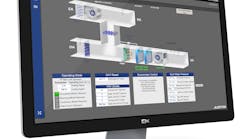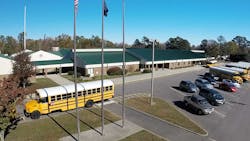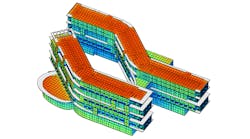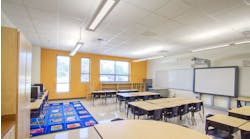People might be surprised to learn that HVAC and lighting in U.S. elementary and secondary schools consume 20 times more energy than the computers in those schools.
As the saying goes, “you can’t fix what you don’t know is broken.” But, how can school facility professionals and administrators understand the specific energy drains unique to their facilities? Many school districts throughout the United States have come to rely on building automation systems (BAS) to monitor and manage their energy consumption. Advanced software makes this easier than ever.
Turn it down, turn it off
At the simplest level, a BAS reduces energy use by ensuring heating and cooling equipment runs only when necessary—for example, by programming the system to automatically lower a school’s HVAC temperature set point after hours or on weekends. Centrally situated facility staff also can respond quickly to real-time changes, such as being able to turn down the heat in schools across a district when a snowstorm forces closures.
A BAS also can integrate with occupancy sensors to further fine-tune energy use. Instead of basic on/off for occupied versus unoccupied conditions, a well-appointed BAS has a standby mode to balance energy savings, building comfort and equipment cycling.
An unoccupied mode might lower the heating set point by 10 degrees Fahrenheit compared with the occupied mode; a standby mode might lower it by 3 degrees. The lower—but not too low—standby set point reduces heating energy consumption while preserving comfort for people who are briefly out of the space (such as a class that goes to an assembly for an hour). Scheduling and occupancy sensors also can be set to control a building’s lighting for additional energy savings.
As an indication of the potential energy savings from a BAS, the Minneapolis/St. Paul area’s Metropolitan Energy Policy Commission estimates $0.20 to $0.40 per square foot in saved utility costs per year. For an average-size grade school of 75,000 square feet, that equals $15,000 to $30,000 in annual savings.
Cost savings beyond energy
School districts typically use a BAS to determine where energy is being wasted, such as heating or cooling un-occupied classrooms. But the systems can save money in other ways, too. A notable example is reducing equipment maintenance costs.
Instead of incurring unnecessary costs maintaining equipment on a set schedule, data provided by a BAS can help optimize maintenance timing—neither too early, nor too late. For example, the Russellville (Ark.) School District uses a BAS to monitor the freezers and coolers throughout its schools. A controls supplier set up the system to sound an alarm when the equipment starts operating outside specifications. Maintenance staff can step in to fix the problem and avoid a potentially costly and disruptive cooler failure in which food is spoiled and extra labor costs are incurred.
As powerful as a BAS is, it is only effective when used properly. If facilities workers do not know how to get the most out of a system, many of its capabilities will go to waste. To that end, it is important when choosing a BAS to look for one that is simple and intuitive to use.
The best-designed BAS user interfaces rely on graphical images to provide strong visual cues of building system status. With such a BAS, a building operator can see what’s happening at a glance; for example, what mode a heating unit is in, and whether it is operating within spec.
Although graphical interfaces can simplify interaction with a BAS, in some systems over-rendered graphics may be a distraction. Consider a photo-realistic image of a fan that shows the exact number and curvature of the blades – interesting to look at, perhaps, but not necessarily useful when what you care about is if the fan is on or off. To that end, a BAS with clear, yet not too detailed graphics helps streamline interaction.
What’s the future?
As more sensors are embedded within building systems, a BAS will need to monitor and provide useful insights on a vast array of data. In light of this, systems are beginning to migrate to the cloud. The cloud, using an outsourced on-demand operating model, provides greater computing power than most school districts could muster using their own resources (from technology levies or district operating budgets). This computing power can help with automated, continuous building commissioning—the ability to ensure that all building systems are performing at the optimal conditions they exhibited when they were installed and commissioned.
The cloud also provides the power for more sophisticated predictive fault detection, diagnostics and analytics for continuously optimizing performance of mechanical equipment. In essence, it further expands the potential for facility operators to use a BAS to save time and money on operations maintenance.
Deulkar is a product manager for Alerton, focusing on the Internet of Things. His experience includes nearly 20 years of engineering, sale and marketing positions for software, hardware and silicon products and solutions for PCs, data centers, supercomputing, RFID and building automation systems. [email protected]



